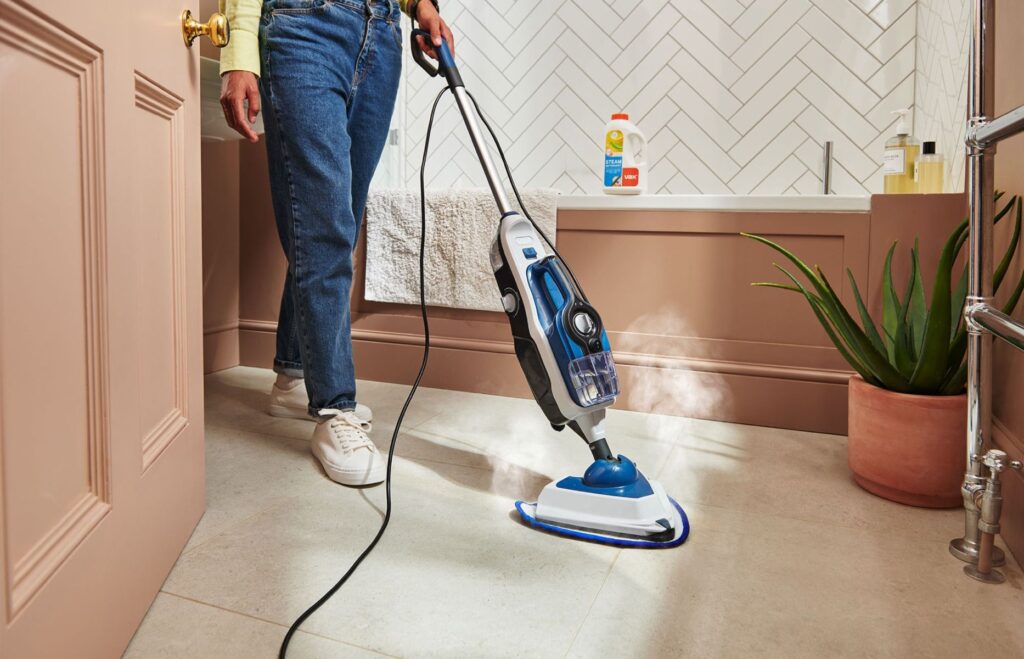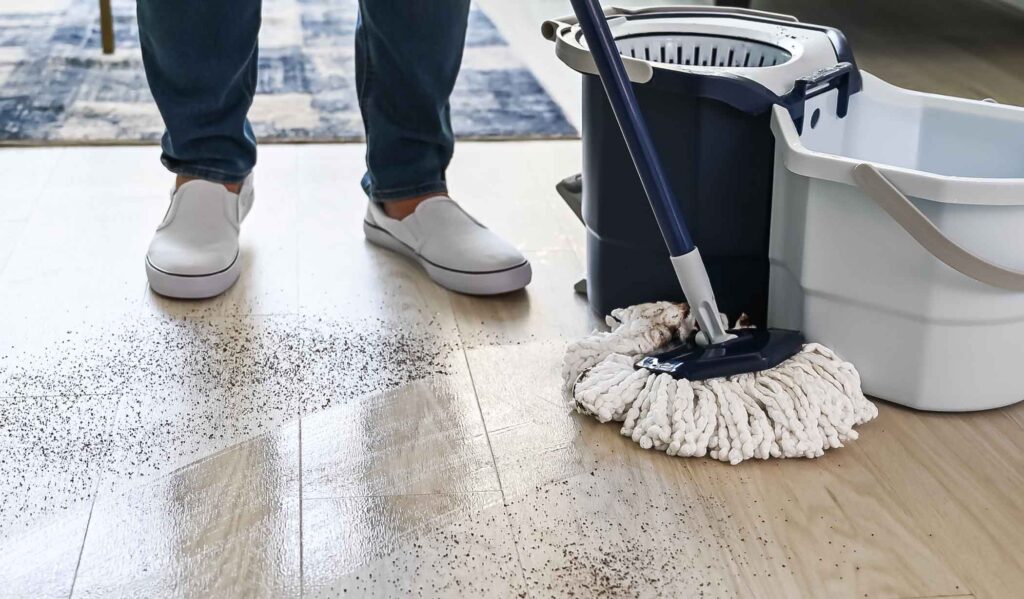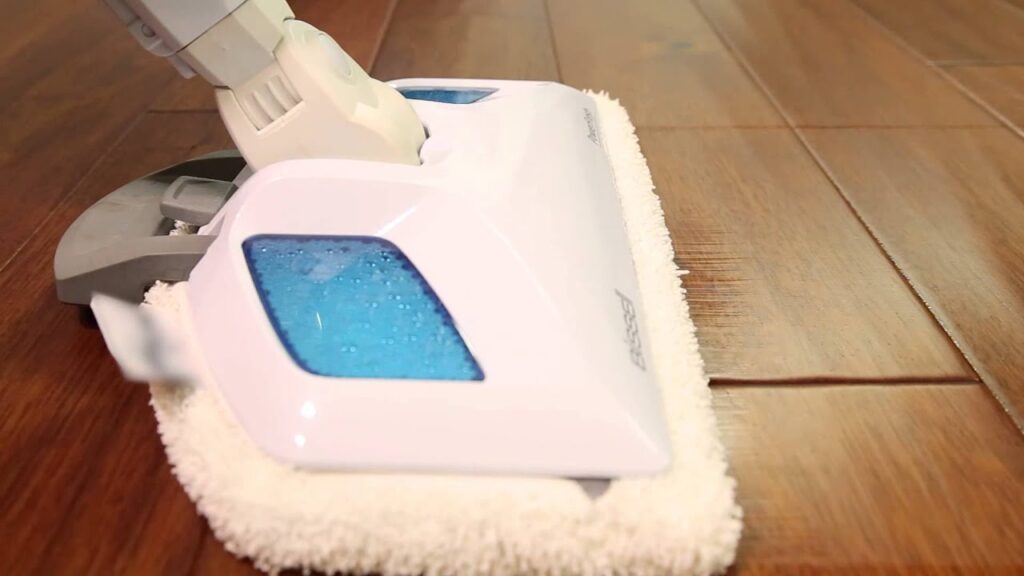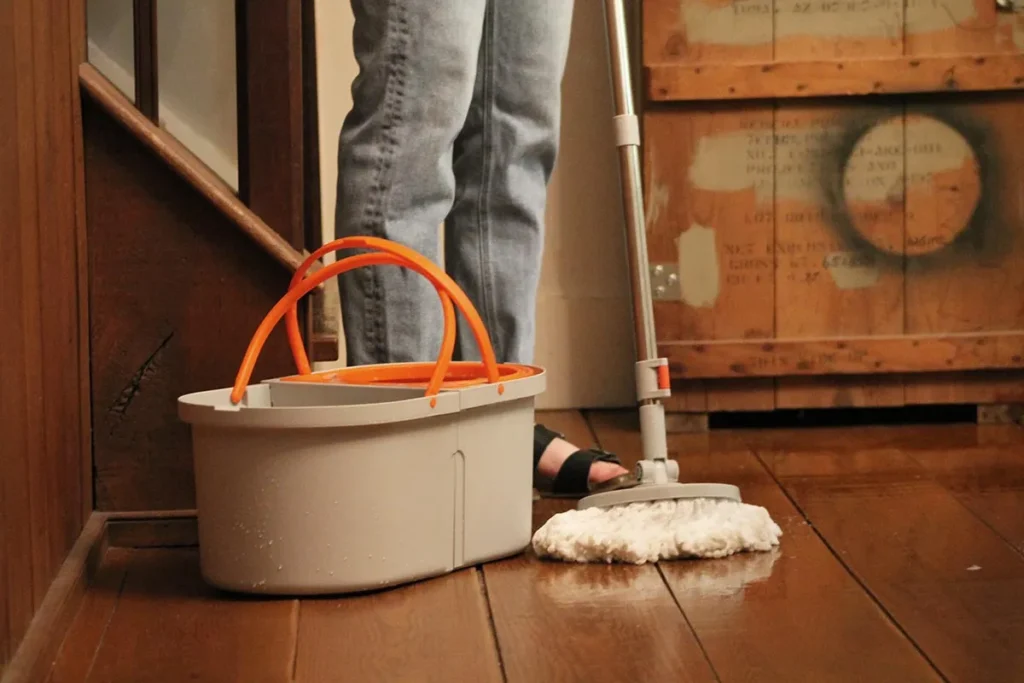Keeping floors spotless has always been one of the most time-consuming parts of housework. Traditional string mops and buckets once ruled the chore list, but in recent years, new designs have transformed how we clean. Among the most popular options today are steam mops and spin mops. Both promise sparkling floors, both have loyal fan bases — and both come with clear trade-offs.
At first glance, the choice seems simple: steam mops use the power of heat and water vapor to sanitize without chemicals, while spin mops rely on a bucket-and-wringer system to control moisture and scrub floors with microfiber pads. But when you dig deeper, you’ll see that the decision isn’t so straightforward. Each mop type has unique strengths that suit specific homes, floor types, and lifestyles — as well as weaknesses that can turn into frustrations if you choose the wrong one.
For instance, steam mops are loved for their ability to kill bacteria and dry quickly, making them a favorite among parents and pet owners. But they also come with limitations: they can warp unsealed hardwood, require electricity, and often have small water tanks that need frequent refills. On the other hand, spin mops are budget-friendly, versatile across almost all floor types, and give you manual control over how wet your mop is. Yet they lack the sanitizing power of steam, leave floors wetter for longer, and demand more elbow grease from the user.
The real challenge for most buyers is figuring out which mop matches their specific needs. Do you live in a busy household with pets tracking in dirt? Do you have mostly tile, laminate, or hardwood floors? Do you prioritize chemical-free sanitizing, or is affordability and versatility more important? These are the kinds of questions that matter — and the answers often point you toward one type over the other.
In this guide, we’ll break down exactly how steam mops and spin mops compare. We’ll look at how each one works, list their pros and cons in detail, and share real-world user insights from people who have lived with them. We’ll also include a side-by-side comparison chart so you can see the differences at a glance. By the end, you’ll have a clear sense of which mop will keep your floors clean without causing extra stress or wasted money.
Because when it comes to floor care, the best mop isn’t the one that looks good on a store shelf — it’s the one that actually makes your cleaning routine easier.
What Is a Steam Mop?

A steam mop is a cleaning tool that uses the power of hot water vapor instead of traditional liquid cleaners. Inside the mop, a small water tank heats up to produce steam, which is then pushed through a microfiber pad at the base. As you glide the mop across the floor, the steam loosens dirt, dissolves sticky messes, and kills bacteria — all without chemical solutions.
Steam mops are especially popular with households that want to sanitize floors naturally. The high temperature (often between 200–250°F / 93–121°C) can kill many common germs and dust mites, making steam a go-to option for families with children or pets. The microfiber pads attached to the mop head also trap dirt as you clean, preventing it from being spread around.
Best Uses for Steam Mops:
- Tile and Stone: Steam can penetrate grout lines and break up built-in dirt.
- Sealed Hardwood: Safe if the wood has a protective finish, but risky on unsealed wood (can warp boards).
- Laminate and Vinyl: Generally safe, but only if the manufacturer approves steam cleaning.
- Allergy-Friendly Cleaning: Great for people sensitive to chemical cleaners.
Limitations:
Steam mops are not universal. On unsealed hardwood or porous stone, the moisture can seep in and cause swelling or cracks. They also require electricity, meaning you’ll be tethered to a cord, and the water tanks are usually small — ideal for quick sessions, but less convenient for large homes.
In short, a steam mop is best for those who want a fast-drying, chemical-free clean with added sanitizing power. It’s not always the most versatile tool, but in the right home, it can feel like a game-changer.
What Is a Spin Mop?

A spin mop is a modern take on the classic mop-and-bucket system, designed to make manual floor cleaning easier and less messy. It typically comes with a mop handle, a round microfiber mop head, and a bucket equipped with a built-in wringer. The wringer uses a spinning mechanism — either foot pedal or hand press — to quickly remove excess water from the mop head. This means you can control how damp or dry the mop is before it touches the floor.
The microfiber mop head is key to the spin mop’s effectiveness. Microfiber is excellent at picking up dust, dirt, and hair, while also scrubbing away sticky messes without scratching floors. Since the mop head is removable and machine washable, it’s also more hygienic and cost-effective than traditional cotton mops.
Best Uses for Spin Mops:
- Hardwood Floors: Because you can wring out most of the water, spin mops are safe when used slightly damp.
- Tile, Vinyl, and Laminate: Works well across almost all hard surfaces.
- Large Areas: The bucket holds plenty of water, making it efficient for big cleaning sessions.
- Everyday Messes: From muddy paw prints to spilled drinks, spin mops are flexible and reliable.
Limitations:
Unlike steam mops, spin mops don’t sanitize with heat — they rely on the cleaning solution you add to the water. Floors may also take longer to dry since the mop uses more water than steam. Spin mops also require more physical effort, as you’re manually scrubbing, wringing, and carrying around a bucket. Storage can be a hassle too, especially in smaller homes.
In short, spin mops are valued for their affordability, versatility, and familiarity. They don’t replace disinfectants the way steam mops can, but for households that want a dependable, all-purpose mop on a budget, the spin mop is a practical choice.
Pros and Cons of Steam Mops

Steam mops have gained popularity for their ability to clean without chemicals and sanitize using only water. But like any cleaning tool, they’re not perfect. Here’s a closer look at what they do well — and where they fall short.
Pros of Steam Mops
- Chemical-Free Cleaning
One of the biggest advantages of steam mops is that they clean with nothing but water. The high heat breaks down dirt and grease, which means no harsh detergents are necessary. This is ideal for households with children, pets, or allergy-sensitive members. - Sanitizing Power
Steam mops can reach temperatures high enough to kill many common household germs, bacteria, and dust mites. For families concerned about hygiene, especially on bathroom or kitchen floors, this makes steam cleaning appealing. - Quick Drying Floors
Because steam uses minimal water, floors dry much faster compared to traditional mopping. This is especially useful for busy homes where kids or pets might track across freshly cleaned floors. - Lightweight and Easy to Use
Most steam mops are slim and easy to maneuver. They glide smoothly over hard surfaces, making them less physically demanding than wringing and scrubbing with a traditional mop. - Great for Grout and Stubborn Stains
Steam is excellent at loosening grime in textured surfaces, especially tile grout. Many users note steam mops outperform regular mops in kitchens and bathrooms.
Cons of Steam Mops
- Limited Floor Compatibility
Steam is not safe for unsealed hardwood, porous stone, or delicate laminate. Moisture can seep in and cause warping, swelling, or cracks. Even on sealed floors, frequent steam use may shorten the finish’s lifespan. - Higher Upfront Cost
Steam mops are more expensive than spin mops. Entry-level models start around $60–$80, while higher-end models can run $150+. Replacement pads also add ongoing costs. - Requires Electricity and Heat-Up Time
Steam mops need to be plugged in and allowed to heat up before use. For quick cleanups, this can feel inconvenient compared to a grab-and-go mop. - Small Water Tanks
Most steam mops have compact water reservoirs, which means frequent refills for larger homes. Cleaning large areas can become stop-and-go. - Risk of Damage if Misused
Leaving the mop sitting in one spot too long can damage floors. Some users report streaks or cloudy patches if the steam is too concentrated. Manufacturer guidelines must be followed carefully.
Summary
Steam mops shine when it comes to sanitizing, chemical-free cleaning, and quick drying. They’re best for households with lots of tile or sealed flooring, and for people who value hygiene and ease of use. However, they’re not the most budget-friendly or versatile option, and they carry risks if used incorrectly.
Pros and Cons of Spin Mops

Spin mops are often described as the “modern upgrade” of the traditional mop-and-bucket system. They’re affordable, versatile, and widely used, but they also come with their own set of strengths and drawbacks.
Pros of Spin Mops
- Affordable and Budget-Friendly
Spin mops are much cheaper than steam mops. Starter sets (bucket + mop) usually cost $30–$50, and replacement microfiber heads are inexpensive and reusable. For budget-conscious households, this makes spin mops a clear winner. - Works on Almost Any Floor Type
Unlike steam, which can damage certain surfaces, spin mops are safe on hardwood, tile, vinyl, and laminate. The ability to wring out excess water means you can safely mop sealed hardwood with just a slightly damp head. - Deep Scrubbing Power
The microfiber mop head is designed to lift dirt, dust, and even sticky messes. When used with a cleaning solution, spin mops can scrub away dried spills more effectively than a steam mop, which relies on heat rather than pressure. - Water Control with Built-in Wringer
The spinning bucket system lets you control how wet or dry the mop is. For delicate floors, you can wring it nearly dry; for tiles or tougher stains, you can use a wetter mop. - Easy to Maintain
Microfiber heads are machine washable and can last for months. Buckets and wringers are sturdy, and replacements are cheap compared to electronic mop parts. - No Electricity Required
Spin mops are fully manual. No cords, no waiting for heat-up time — just dip, spin, and mop. This makes them more convenient for quick messes.
Cons of Spin Mops
- Requires More Physical Effort
Unlike a steam mop that glides and sanitizes with heat, spin mops require scrubbing power from you. Larger spaces or heavy messes can become tiring. - Less Sanitizing Power
Spin mops clean well but don’t kill bacteria on their own. They rely on the cleaning solution you add to the water. Without disinfectant, they may not sanitize as effectively as steam. - Longer Drying Time
Spin mops use more water than steam mops. If you don’t wring the head properly, floors can stay damp longer — not ideal for hardwood, where excess water risks warping. - Bulky Storage
The bucket-and-mop setup can take up more space than a slim steam mop. For small apartments, storage might be inconvenient. - Risk of Spreading Dirty Water
If you don’t refresh the bucket often, you could be mopping with dirty water, which spreads grime rather than removing it.
Summary
Spin mops excel in affordability, versatility, and scrubbing ability, making them a practical choice for most households. However, they don’t sanitize like steam, require more physical effort, and leave floors wetter. They’re best for families looking for a reliable, low-cost option for everyday messes — especially in homes with multiple flooring types.
Steam Mop vs Spin Mop: Quick Comparison
| Feature / Factor | Steam Mop | Spin Mop |
| Cleaning Method | Uses heated steam to loosen dirt & kill germs | Uses microfiber mop head with water/solution |
| Sanitizing Power | High — kills many bacteria with heat | Low — depends on cleaning solution used |
| Chemical Use | None required (water only) | Requires detergent/disinfectant for best results |
| Floor Compatibility | Best for tile, sealed hardwood, vinyl; unsafe on unsealed/porous floors | Safe for most floor types (hardwood, tile, laminate, vinyl) |
| Drying Time | Quick (minimal water left behind) | Slower — can leave floors damp if not wrung well |
| Ease of Use | Lightweight, glides easily; requires electricity | Manual effort needed for scrubbing & wringing |
| Setup & Convenience | Plug in, heat water (1–2 mins), small tank | Ready instantly; bucket provides long cleaning sessions |
| Cost | Higher ($60–$150+) plus pad replacements | Lower ($30–$50) plus inexpensive mop head replacements |
| Maintenance | Replace microfiber pads; descale tank if needed | Wash mop heads; clean bucket periodically |
| Storage Needs | Slim design, easy to store | Bulky — mop + bucket require more space |
| Best Suited For | Homes wanting chemical-free sanitizing, allergy-sensitive families, tile-heavy spaces | Budget-friendly, everyday cleaning on mixed flooring, bigger messes |
At a glance:
- Steam Mop = best for sanitizing, quick drying, and eco-friendly cleaning.
- Spin Mop = best for affordability, versatility, and deep scrubbing power.
Real-World Reviews & Insights
Marketing promises often sound perfect, but the best way to judge cleaning tools is by listening to the people who use them daily. Both steam mops and spin mops have loyal fans — and critics. Here’s what real users across Amazon, Reddit, and cleaning forums say about each.
Steam Mop: What Users Love
- Sanitizing without chemicals: Many parents rave about using steam mops in kitchens and play areas because they don’t want bleach or detergents around crawling children or pets. One Amazon reviewer wrote: “I feel better letting my baby play on the floor after steam cleaning — no chemical smell, just clean.”
- Great for grout: Steam mops often get praise for how well they lift dirt from tile grout. A Reddit user shared: “I thought my bathroom tiles were permanently gray. One session with the steam mop and the grout looked brand new.”
- Quick drying: People with pets mention that steam mops dry so fast that animals can walk over the floors minutes later without leaving paw prints.
Steam Mop: Common Complaints
- Limited on wood floors: Many users warn that steam mops damaged or dulled their hardwood over time. One review: “I used steam on my hardwood for a few months and started seeing warping near the seams. Never again.”
- Small tanks: Large home owners find frequent refilling frustrating.
- Durability issues: Some mid-range models break after a year of heavy use, especially pumps or heating elements.
Spin Mop: What Users Love
- Affordable & effective: Spin mops often get five-star reviews for delivering good results at a fraction of the cost of steam mops. A buyer wrote: “$35 for a spin mop and my tile floors look amazing. Can’t beat the price.”
- Control over water use: Hardwood floor owners like being able to wring the mop nearly dry. “I can use it on my oak floors without worrying about water damage,” one homeowner said.
- Versatility: Spin mops get high marks for tackling everything from muddy paw prints to spilled juice. They also work on walls and baseboards.
Spin Mop: Common Complaints
- Physical effort: Some users find wringing and scrubbing tiring compared to gliding a steam mop.
- Messy bucket system: A recurring frustration is that dirty water quickly builds up in the bucket. Unless replaced often, users feel like they’re “just spreading dirty water around.”
- Longer drying time: Floors can take 15–30 minutes to dry, which is an issue in busy households.
Overall Sentiment
- Steam mop users love the sanitizing power and fast results but warn strongly against using them on delicate or unsealed wood. They’re happiest in tile-heavy homes or households with kids/pets where hygiene is top priority.
- Spin mop users love the low cost, simplicity, and versatility but admit it doesn’t have the same sanitizing punch. They’re happiest in mixed-floor homes where a safe, budget-friendly solution is needed.
User Insight Takeaway:
If you read through dozens of user experiences, one pattern emerges:
- Steam mop fans value peace of mind (chemical-free sanitizing).
- Spin mop fans value practicality and cost savings.
Neither is “better” overall — the right choice depends entirely on your household’s flooring, lifestyle, and priorities.
Buying Considerations: Which Mop Is Right for You?
Choosing between a steam mop and a spin mop isn’t about which one is “better” overall — it’s about which fits your home, flooring, and lifestyle. Here are the main factors to weigh before making a decision.
1. Type of Flooring
- Tile & Stone: Steam mops excel here. They loosen dirt from grout lines and sanitize without chemicals.
- Sealed Hardwood: Both can work, but spin mops are generally safer because you control the water. Steam can damage wood if the seal isn’t perfect.
- Laminate & Vinyl: Spin mops are safer, as steam may cause swelling if it seeps into seams.
2. Household Needs
- Families with Kids or Pets: Steam mops are great for sanitizing without harsh chemicals, giving peace of mind.
- Busy Homes: Spin mops cover large areas without frequent refilling, making them practical for heavy messes.
3. Budget
- Steam Mops: Cost $60–$150 upfront, plus pad replacements. Good long-term if sanitizing is a priority.
- Spin Mops: Cost $30–$50 with cheap, washable heads. Best for those who want a reliable, low-maintenance option.
4. Ease of Use
- Steam Mop: Lightweight, glides easily, minimal effort — but needs electricity and heat-up time.
- Spin Mop: More manual effort, but ready to use instantly and doesn’t require cords.
5. Storage & Space
- Steam Mop: Slim, easy to tuck into a closet.
- Spin Mop: Bulkier (bucket + mop), which can be tricky in smaller apartments.
Decision Tip
- If you want sanitizing, eco-friendly cleaning, and convenience for small/medium spaces, a steam mop makes sense.
- If you want affordability, all-floor versatility, and simplicity for larger messes, a spin mop is the better fit.
FAQs: Steam Mop vs Spin Mop
- Can a steam mop replace regular mopping?
Not entirely. Steam mops are excellent for sanitizing and lifting light dirt, but they’re less effective on sticky spills or heavy grime unless you pass over them multiple times. Many homeowners use steam mops for maintenance cleaning and keep a spin mop (or traditional mop) for tougher messes. - Are steam mops safe for hardwood floors?
Only if the hardwood is sealed. On unsealed or poorly sealed wood, moisture from steam can seep into seams and cause warping or swelling. Even with sealed wood, frequent steam use may shorten the finish’s lifespan. When in doubt, stick with a slightly damp spin mop for hardwood. - Do steam mops need cleaning solutions?
No. Steam mops work with plain water only. Adding cleaners can damage the machine. The heat itself is what sanitizes and loosens dirt. For fragrance, some brands sell specific water additives, but these aren’t necessary. - Are spin mops hygienic?
Spin mops clean effectively, but they don’t sanitize unless you add a disinfectant to the water. The bucket system can also spread dirty water if not changed often. To keep it hygienic, refresh the bucket frequently and wash mop heads after each session. - Which dries floors faster: steam mop or spin mop?
Steam mops leave very little water behind, so floors dry in minutes. Spin mops can leave floors damp for 15–30 minutes depending on how much water you wring out. For households where pets or kids walk through quickly, steam mops are more convenient. - Which mop is better for large homes?
Spin mops are more practical for large spaces because the bucket holds plenty of water. Steam mops have small tanks, which require frequent refilling during long cleaning sessions. - Which lasts longer: steam mop pads or spin mop heads?
- Steam mop pads: Usually last a few months with regular use; replacements cost more but are easy to wash.
- Spin mop heads: Microfiber heads can last 3–6 months if washed properly; replacements are inexpensive and widely available.
- Do spin mops scratch floors?
No, the microfiber heads are gentle on hardwood, laminate, and tile. However, debris like sand or grit should be vacuumed first to avoid scratches. - Which mop is easier to store?
Steam mops are slim and closet-friendly. Spin mops take more space since you need to store the mop and bucket together.
Quick takeaway: Steam mops excel at sanitizing and fast-drying, while spin mops win on versatility, affordability, and deep cleaning. Many households actually keep both for different situations.
Conclusion
When it comes to keeping floors clean, both steam mops and spin mops bring valuable strengths to the table — but neither is a one-size-fits-all solution. The real question isn’t “which is better?” but rather “which is better for you?”
Steam mops are ideal for households that want chemical-free sanitizing and fast-drying results. They’re excellent on tile, sealed hardwood, and bathrooms where germs are a concern. The ability to kill bacteria with nothing but water appeals to families with pets, young children, or anyone sensitive to chemical cleaners. However, their limitations are clear: they’re more expensive, require electricity, and can damage unsealed or delicate flooring if misused.
Spin mops, on the other hand, win on affordability, versatility, and simplicity. They’re safe for nearly every type of floor, give you manual control over water use, and handle bigger messes without the stop-and-go refilling of a steam mop. They do require more effort, and they don’t sanitize without added cleaners, but their practicality makes them a reliable everyday option for most homes.
For many people, the best approach is not choosing one over the other but recognizing their complementary roles. A steam mop works perfectly for routine sanitizing and quick refreshes, while a spin mop shines for heavy-duty messes and larger areas. Together, they can cover nearly every cleaning scenario.
At the end of the day, the “winner” depends on your home’s flooring, your lifestyle, and your priorities. If you want speed and sanitizing power, go steam. If you want flexibility and value, go spin. Either way, with the right mop, you’ll spend less time worrying about floors — and more time enjoying the clean space you worked for.



